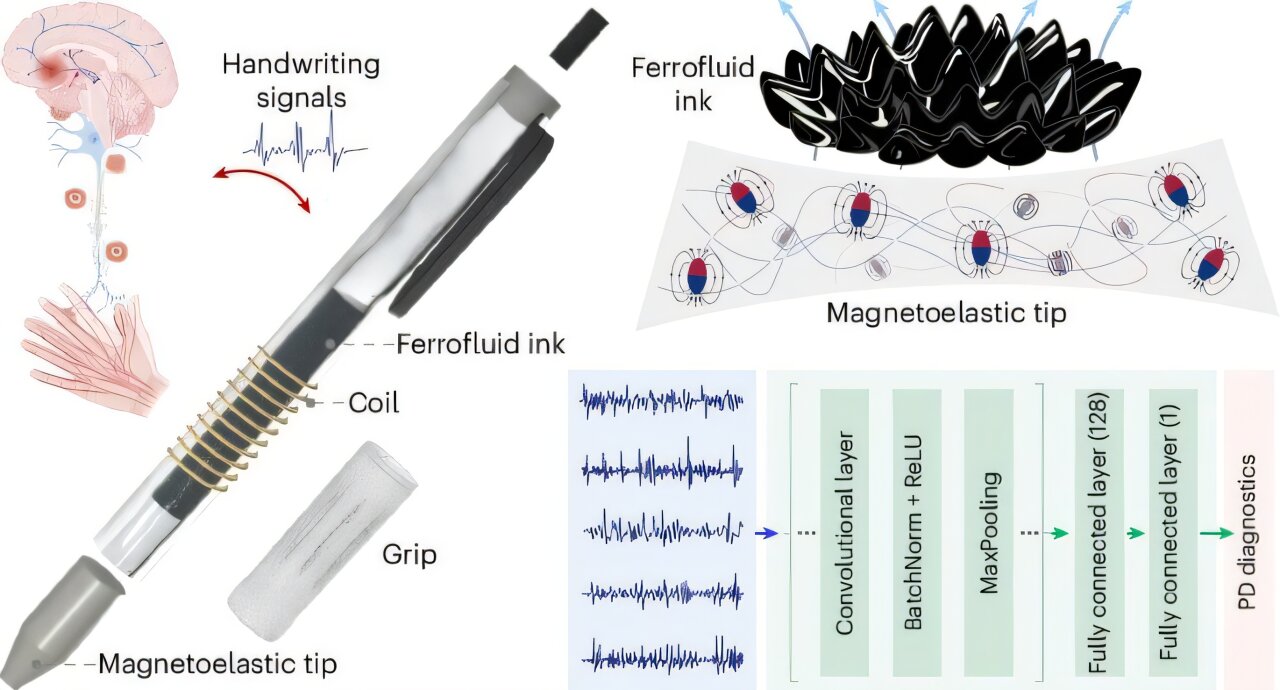It’s easy to overlook the beauty of handwriting—each letter a silent witness to the fluid choreography between mind and muscle. But for individuals living with Parkinson’s disease, this delicate coordination often becomes one of the first casualties. The tremors, stiffness, and slowed movement that characterize Parkinson’s subtly sabotage the fluidity of penmanship, long before clinical symptoms become undeniable. Now, a team of engineers and neuroscientists at the University of California, Los Angeles (UCLA) has transformed this vulnerability into an opportunity.
Their creation? A deceptively simple-looking pen that may very well change the way Parkinson’s disease is detected—early, accurately, and affordably.
The Invisible Struggle Behind the Signature
Parkinson’s disease is a progressive neurodegenerative disorder that damages the motor system, often without mercy. It creeps into a person’s life, affecting their balance, gait, speech, and the fine motor skills so essential for daily life. Among the earliest and most telling signs of this decline is a phenomenon known as micrographia—abnormally small, cramped handwriting that becomes increasingly illegible.
Today’s standard of care for diagnosing Parkinson’s still leans heavily on clinical observations. Patients are typically assessed by neurologists based on visible movement patterns, reported symptoms, and cognitive evaluations. But this process is subjective by nature. A physician’s experience, available technology, and even a patient’s ability to articulate their symptoms can all skew the result. Worse still, many patients in rural or underserved regions never reach a specialist in time. While biomarker-based diagnostics and advanced brain imaging do offer more objectivity, their high costs and complexity make them impractical for routine or global screening.
What if something as ordinary as a pen could change all that?
A Pen That Listens to the Body’s Whispers
In a recent study published in Nature Chemical Engineering titled “Neural network-assisted personalized handwriting analysis for Parkinson’s disease diagnostics,” UCLA researchers unveiled an ingenious invention—a pen that quite literally listens to your hand as it moves.
Unlike smart pens or styluses that rely on visible ink trails or tablet sensors, this diagnostic pen doesn’t care what the handwriting looks like. Its magic lies in capturing the invisible—the force, tension, and movement dynamics that course through the hand when a person writes.
Its tip is no ordinary ballpoint. Constructed from a silicone-based material embedded with magnetic particles, the tip houses a ferrofluid ink—a suspension of nanoscale magnetic particles. When someone writes, draws, or even traces letters in the air, the pressure they exert deforms the tip and moves the ink. These subtle actions trigger shifts in the magnetic field, which in turn generate a measurable voltage inside a tiny embedded coil. The result is a real-time stream of electrical signals, each one a biometric fingerprint of the writer’s neuromuscular performance.
A Pilot Study with Big Implications
To evaluate this technology, the research team recruited 16 participants for a pilot study at UCLA Medical Center. The group included three individuals diagnosed with Parkinson’s disease and thirteen healthy control subjects. The participants were asked to perform a variety of handwriting tasks: simple lines, spirals, letters, and shapes—both on paper and in the air.
Crucially, the pen didn’t just record the end product of these tasks. It recorded the process—the smoothness of the motion, the pressure applied, and the minute vibrations and hesitations that might otherwise go unnoticed.
Once the data were collected, they were fed into multiple machine learning models. The star performer was a one-dimensional convolutional neural network (1D-CNN), which achieved a staggering 96.22% accuracy in identifying participants with Parkinson’s disease. The model was able to detect even the subtlest disruptions in motor control—disruptions so fine they might elude even experienced clinicians.
Why This Pen Could Change Everything
This is more than just a novel piece of technology—it’s a paradigm shift.
Traditionally, diagnosing Parkinson’s has relied on watching how someone moves. But visual observation has limits. It’s affected by the observer’s skill, the patient’s anxiety, the lighting in the room, and a host of other variables. And more advanced tools like PET scans and CSF biomarker testing, while effective, are invasive and expensive. They’re simply not realistic for routine use.
This pen sidesteps all of those limitations. It’s non-invasive, portable, and low-cost. It can be used in a clinic, at a community health center, or even in a person’s living room. The setup is minimal, the learning curve low, and the potential for impact immense.
Moreover, because the pen measures real-time motor signals instead of relying on the final written output, it captures data that’s often hidden in plain sight. It doesn’t matter whether someone writes perfectly or illegibly—the system reads the biological energy behind the movement.
The Science Behind the Scribe
The pen’s operation hinges on magnetoelasticity—a property of materials that change their magnetic characteristics when mechanically deformed. When a person writes with the pen, the pressure applied deforms the silicone tip, rearranging the orientation of its magnetic particles. Meanwhile, the ferrofluid ink—composed of magnetic nanoparticles suspended in liquid—moves in response to the writer’s pressure and speed, causing subtle shifts in the magnetic field. A miniature coil within the pen detects these changes, converting them into voltage patterns.
These voltage patterns are then digitized and sent through a classification pipeline powered by machine learning algorithms. The neural network sifts through the data, searching for the neural signatures of Parkinson’s: tremors, rigidity, delayed initiation, and inconsistent pressure. The result is a binary decision—PD or not PD—but the richness of the data opens doors to even more detailed insights.
Moving from Detection to Management
Early diagnosis is only the beginning. One of the most exciting implications of this technology is its potential for ongoing disease monitoring. Parkinson’s is a disease that evolves over time, and tracking its progression is essential for tailoring treatment.
Today, clinicians often rely on patient reports or brief in-office observations to assess disease severity. But these snapshots miss the day-to-day variability that characterizes the patient experience. With a diagnostic pen like this, patients could periodically complete writing tasks at home, generating data that reflect their motor function over time. This continuous monitoring could inform medication adjustments, trigger follow-up appointments, and help researchers study the progression of the disease in more nuanced ways.
Democratizing Neurological Healthcare
Perhaps the most revolutionary aspect of this invention is its accessibility. Sophisticated brain imaging requires multimillion-dollar equipment. Biomarker assays need specialized labs. But pens? Pens are everywhere.
Imagine a future where community clinics in low-income countries could screen for Parkinson’s using a tool that costs less than a stethoscope. Picture schools, retirement homes, and pharmacies offering quick handwriting screenings as part of routine health checks. Envision a world where catching Parkinson’s early isn’t a privilege, but a norm.
That’s the future UCLA’s diagnostic pen hints at.
A Step Toward Data-Driven Neurology
As medicine embraces data science, the need for objective, quantifiable, and repeatable diagnostics becomes more urgent. This pen doesn’t just measure movement—it digitizes human motion, turning biology into numbers, which can then be compared, tracked, and analyzed over time.
With every user, the system gets smarter. As more handwriting samples are collected across diverse populations, the neural network can be trained to distinguish between Parkinson’s and other movement disorders like essential tremor, dystonia, or even early signs of cognitive decline. In time, the pen might evolve into a platform for diagnosing multiple neurological conditions with a single stroke.
Beyond the Lab: What Comes Next
Of course, the road from prototype to widespread clinical use is long. The study conducted at UCLA involved a small sample size—just sixteen individuals. While the accuracy is impressive, larger, more diverse cohorts will be necessary to validate its performance across populations, disease stages, and cultural handwriting variations.
Future versions of the pen might be connected to smartphones or cloud platforms, allowing automatic data upload and analysis. With built-in AI, such systems could deliver instant feedback, suggest follow-ups, or even connect users with neurologists remotely.
Regulatory approval, manufacturing scalability, and user adoption remain challenges. But with its compelling promise and low barrier to entry, the diagnostic pen has a rare edge—one that bridges cutting-edge science with real-world practicality.
A Stroke of Genius with Human Impact
At the heart of this story lies a profound insight: that health is encoded in the way we move, even in the way we write our names. UCLA’s diagnostic pen doesn’t just detect disease—it gives voice to the quiet suffering of millions who may not yet know what’s changing inside their bodies.
And perhaps that’s the most beautiful part. With every line drawn, every letter penned, this small tool offers a whisper of hope—a message written not in ink, but in information.
As technology continues to blur the line between science fiction and reality, this pen reminds us that some of the most transformative tools don’t need to be complicated. Sometimes, they just need to listen—to the body, to the data, and to the patients who have waited too long for a simpler, smarter way forward.
Reference: Guorui Chen et al, Neural network-assisted personalized handwriting analysis for Parkinson’s disease diagnostics, Nature Chemical Engineering (2025). DOI: 10.1038/s44286-025-00219-5






